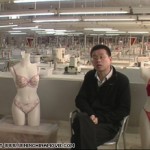The Center is Holding, with Troubles at the Periphery
The first in a series of three articles on “China – On the Road to 2025.”
On October 19, the Council on Foreign Relations and Project 2049 Institute cosponsored “China 2025,” a conference exploring where China may be in the next 15 to 20 years. Guest blogger Marcy Nicks Moody seeks to illuminate several of the arguments made and issues discussed, namely, domestic trends, foreign policy, and the economic outlook.

Lingerie entrepreneur Zhou “The Wolf” Yu from Win in China. Could more wolves make better governance?
The Center is Holding, with Troubles at the Periphery
by Marcy Nicks Moody
As discussed in a previous post, the October 1 celebrations of the 60th anniversary of the founding of the People’s Republic were spectacular. President Hu Jintao’s updated Mao jacket, the Mount Everest float, and the female soldiers with fuschia miniskirts and submachine guns were all flawless, if unlikely. Mostly a parade of military weapons systems, the celebrations were an extraordinary display of pride in what China has accomplished over the last 60 years, and confidence in what it will accomplish over the next.
Since the beginning of ‘reform and opening’ (the period starting in 1978 when new leader Deng Xiaoping first instituted China’s economic reforms), China has consistently defied expectations about what it can accomplish. When considering where China will be in 2025, then, thinking not about where we, the outside observers, expect China to be, but rather where China itself aspires to be is perhaps the more apt starting point. And the National Day parade may offer some insight into these aspirations: the Chinese Communist Party-state of October 1, 2009 is strong and confident; it clearly sees an important role for the People’s Republic internationally, and little release of political control nationally.
But this picture stands in contrast to the China of September 2009, during which dissidents were detained, social networking websites were blocked, and civil society was suppressed. Or the China of March 2009, when a Christie’s auction of Chinese antiquities elicited an uproar among the Chinese people as a symbolic attack on its culture. Last year, Bjork, the Icelandic pop singer otherwise known for her off-beat sartorial choices, produced a similar response from the Chinese people when she called for independence for Tibet. Similar with Carrefour, the French big box store, which became the victim of a nation-wide boycott of foreign goods at the behest of a single Chinese blogger. The China of these moments finds disagreement unbearable, and portrays itself as easily harmed by the actions of relatively minor interlocutors. Strong and confident are not the appropriate descriptions of this picture.
How does one make sense of this divergence in tone? At Monday’s “China 2025” conference, the first presenter, Minxin Pei of Claremont McKenna College argued that it is reflective of China’s domestic circumstances, which may be characterized by a combination of macro-level stability and micro-level instability. On the macro-level, there is no organized opposition to the Chinese Communist Party (CCP). China’s response to the economic crisis has been capable and robust, and there is increasing interest in the propagation of Chinese “soft power.”
Though center is holding, there are problems elsewhere. Four hundred CCP members are found guilty of corruption every day, said Professor Pei. There are 300 riots per day. Concerns about food and product safety cause great anxiety, and there is a major water pollution incident every three days. Kelley Currie, a Non-resident Fellow at the Project 2049 Institute and another speaker on the panel, noted tensions between the Han and other ethnicities at the periphery, including Tibetans, Uighurs, Manchus, and Mongols. Though none of these problems has occurred at the locus of CCP power, this dynamic, which Yanzhong Huang of Seton Hall University described as the central-local capacity gap in Chinese governance, poses a serious challenge to the effectiveness of domestic policy in China.
How, then, will micro-level instability affect China’s aspirations for and its path to 2025? To be sure, the Party-state currently has few effective methods for systematically addressing a range of local-level issues, including corruption, environmental degradation, ethnic unrest, and labor-related issues, which could eventually pose a more serious threat to the Party-state. More of an optimist, director of the documentary film Win in China Ole Schell observed that increased business and commercial activity may also drive increased transparency in China, while Professor Pei calls himself a cautious pessimist. This author, however, would rarely bet against China.
Marcy writes about China. In 2007-08, she was a Fulbright Scholar in China, where she was also a Research Fellow with the U.S.-Asia Law Institute. She received an M.A. in East Asian Studies from Columbia University and graduated from Brown University.
 On Facebook
On Facebook By Email
By Email 
[…] third and final in a series of articles regarding China, On the Road to 2025. Click here for Part 1; Here for Part […]
[…] second in a series of three articles regarding China, On the Road to 2025. Click here for Part […]